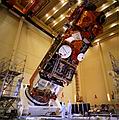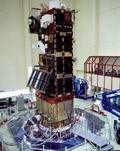 Envisat fast facts
Envisat fast facts 
Envisat is the size of an articulated truck
10m Χ 4m Χ 4m with solar panel and ASAR stowed
25m Χ 7m Χ 10m with solar panel and ASAR deployed
Weight
8200 kg at launch
Includes 300 kg
hydrazine fuel for orbit control thrusters
Power
Solar array generates 6.6 kW of
electricity after five years in orbit

Orbits Earth every 100 minutes at altitude 800 km
Global coverage every 3 days (for most instruments)
Exact repeat coverage every 35 days
Lifetime
5 years design life
Both of
ESAs previous Earth Observation Satellites, ERS-1 and 2, significantly
exceeded their design lifetimes
Instruments
Ten instruments observing Earth
In wavelengths from 0.2 micrometer to 10 cm
Data gathering
Envisat will collect 1 Petabyte
(1015 bytes) of data over its lifetime
Enough to fill the
hard disk drives of a million desktop PCs.

2 x100 Mbit/s links via European Data Relay Satellite
2 x100 Mbit/s direct downlinks to ground receiving stations
Each link 2000 times faster than a standard computer modem
Data storage
160 Gbits total data storage on
board
Enough for 1.6 million square kilometres of SAR imagery plus
one complete orbit of data from all the other sensors
Construction
Satellite built by consortium of
50 companies led by Astrium
Ground Segment built by consortium of 20
companies led by Alcatel Space Industries
Launcher
Ariane-5 launch vehicle from Europes
Spaceport, Guyana Space Centre.
Cost
2 billion Euro over 15 years
Works
out at 7 Euro per citizen for ESA member nations or about 1 cup of coffee
each a year
Participating states
Austria, Belgium, Canada,
Denmark, France, Finland, Germany, Italy, Netherlands, Norway, Spain,
Sweden, Switzerland, United Kingdom